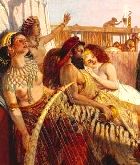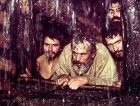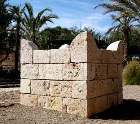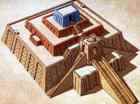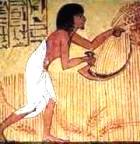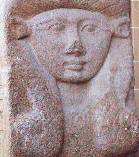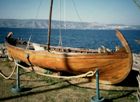Paintings: Noah & the Deluge
‘Noah’s Ark’, Edward Hicks, 1846
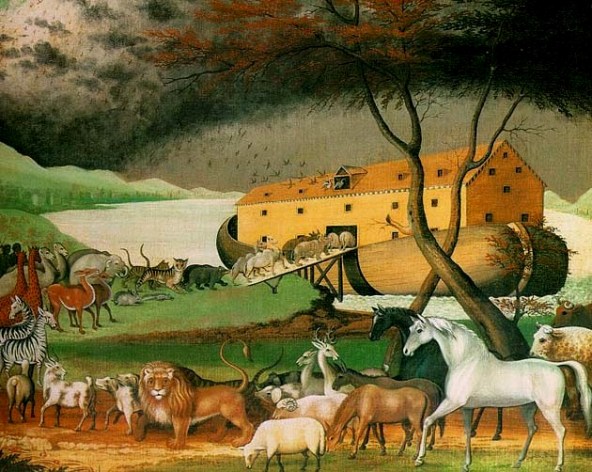
The animals enter two by two. In this case the lambs and the lions are together, unconcerned. The ark waits to receive them, while storm clouds gather behind.
There is a mood of serene harmony. Order is the order of the day. Meanwhile chaos, in the form of ominous storm clouds, approaches.
Between the order of the animals and the chaos of the storm-clouds stands the church-like ark, waiting to receive anyone who will enter.
Noah builds the Ark
‘The Entry of the Animals into Noah’s Ark’
Jan Brueghel the Elder, 1613
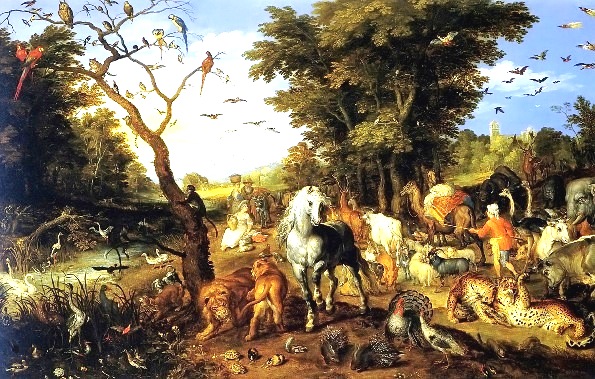
The ark is not shown, but it must be nearby, since the animals assemble at Noah’s command. He herds them as they mingle peacefully together – these are God’s saved creatures who do not harm each other. They are saviours of their species.
The birds seem to be arriving of their own volition, flocking in from afar. What a sight that must have been…
Jan Brueghel the Elder has painted the sky sunny and clear: there is no hint of trouble ahead. It is an idyllic scene of abundant Nature, with Noah’s family picnicking on the banks of the stream. But the clock is ticking….
Bible reference: Genesis 6-7
‘Noah’s Ark’, Franzosischer Meister ‘The French Master’, 1675
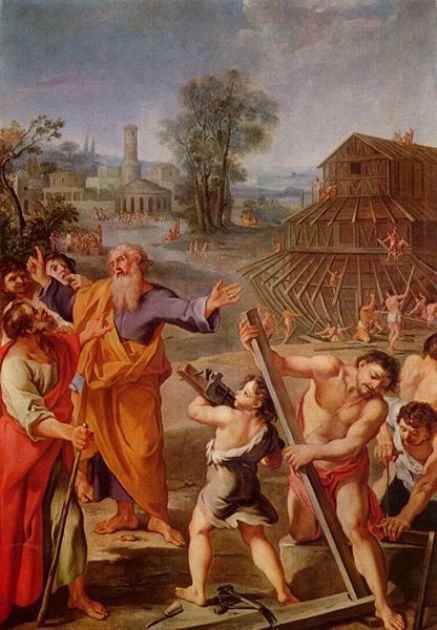
Noah warns the people about the impending disaster, but they listen to him with amused scepticism. Undeterred, he rallies the troops to keep on building, while behind him the storm clouds gather.
On the left side, the populace listens to Noah’s mad raving.
But the right side of the painting is a hive of activity, as the sons of Noah work frantically to complete the ark before the clouds darken any more.
The French Master has captured the urgency of the moment – and something of the futility of warning people about the consequences of their actions.
‘The Eve of the Deluge’, William Bell Scott, 1865
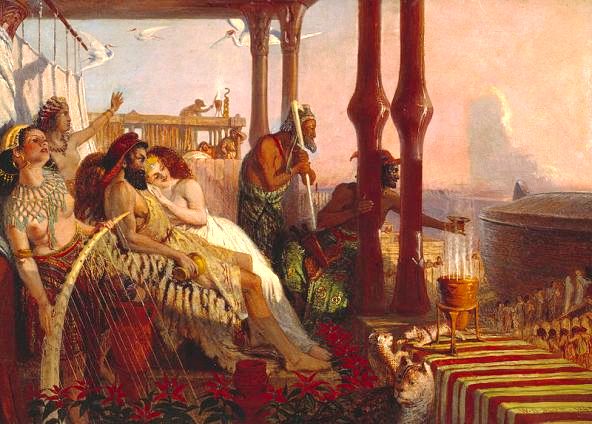
The rich, wicked inhabitants of the earth watch with amusement as Noah completes the ark. Their luxury and indolence are equated with evil – this picture was painted in the industrious mid-Victorian era.
The Bible says ‘…the wickedness of humankind was great in the earth, and every inclination of the thoughts of their hearts was only towards evil.’ They are enjoying the evening sunlight. But on the horizon a great cloud begins to form…
Note: Noah was decidedly counter-cultural in his worship of a single god, placing himself at odds with the established religions of the ancient world. 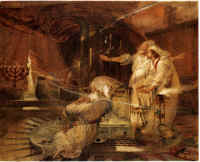
William Bell Scott painted a number of religious paintings. ‘The Rending of the Veil’, painted three years after ‘The Eve of the Deluge’, shows the moment of Jesus’ death, when the curtain in the Temple is torn from top to bottom. Another pivotal moment in history…
Bible reference for this part of Noah’s story: Genesis 6
Going into the Ark
‘Story of Noah’, Lorenzo Ghiberti, circa 1420
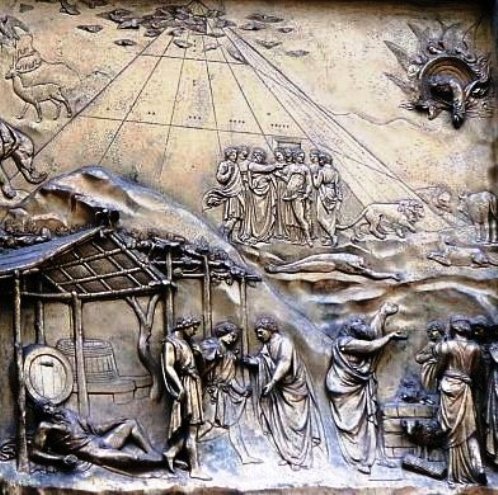
- In the top section, Noah warns his family about the impending deluge; the animals begin moving towards him.
- In the bottom right, Noah and his family offer sacrifice to God on the altar they have built.
- In the bottom left Noah lies drunk on the floor while his sons argue about what to do.
This panel from the Gates of Paradise in Florence is puzzling. Ghiberti seems to have given prominence to the story of Noah’s drunkenness – this is the part of the panel that captures the eye first. The story of the Deluge is relegated to second or even third place.
Perhaps Ghiberti wished to focus on the aftermath of the Flood, and what humanity would do with its second chance. Your thoughts?
Child’s toy, Unknown maker, 18th or 19th century
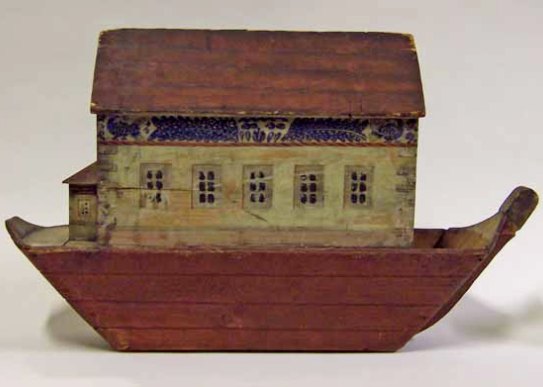
The ark as it might have looked if the Flood had occurred in the 18th or 19th century…
Art comes in all forms and this model, built as instruction for a child, shows the way the stories of the Bible permeated daily life during the 19th century. Preserved at the Manchester Art Gallery, the maker of this model was comfortable imposing 19th century architecture onto the mythic world of Noah.
The Flood
‘The Deluge’, Francis Danby, 1840
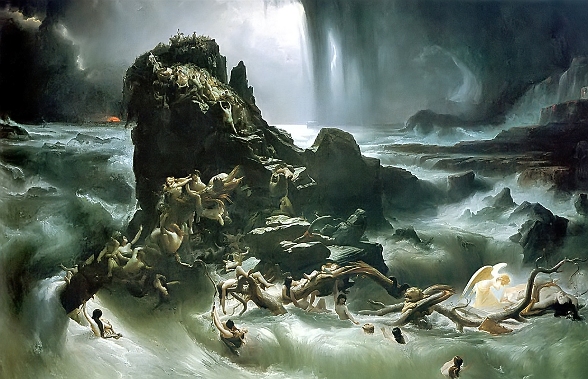
The Deluge by Francis Danby c. 1837
The overpowering fury of the storm washes hapless humanity away from the rock they cling to. Earth and sky are full of water.
Danby specialized in paintings with epic subjects – this one is typical. Water dominates the landscape, and humans are dwarfed by it.
In the background, under a single shaft of moonlight, is the ark. It is the only thing that seems calm.
The waters swirl, dragging animals and people down as they desperately try to cling to the mountain peak, now almost overwhelmed.
‘Aquae diluvii super terram’, Salvador Dali, 1964
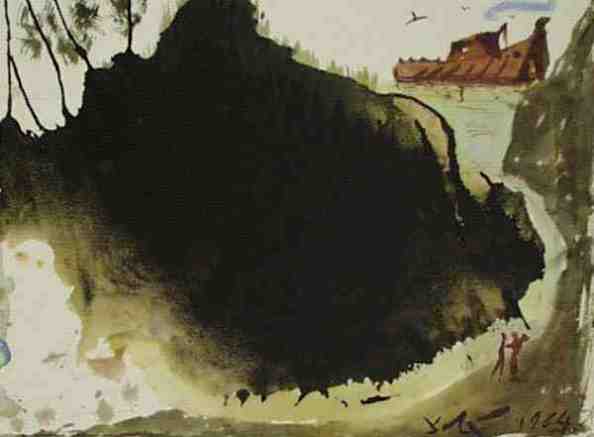
Salvador Dali _ Die heilige Bibel (1964-1967)
The Flood itself dominates this painting; behind it, however, the light surrounding the ark and the dove draw the viewer’s eye.
This terrifying image of a monstrous flood has poignant significance. Dali painted it after the 1962 flash flood in Barcelona, which killed nearly a thousand people. The horror of mud and destruction is captured in the black menacing central form, though hope too is expressed in the ark and the dove behind.
‘The Flood’, Norman Adams RA, 1970’s
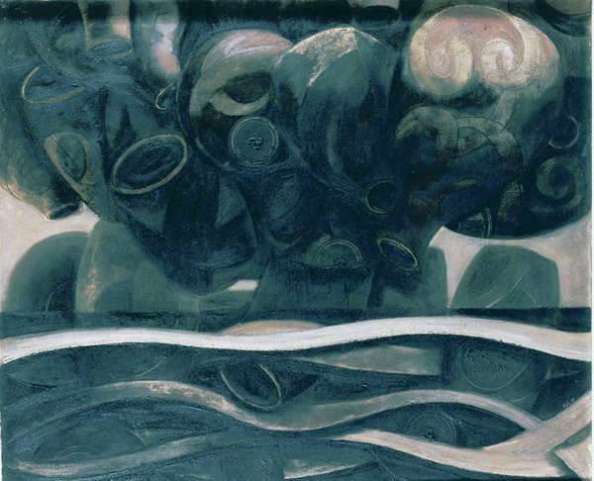
Massive storm clouds in the form of water flasks gather over the earth, ready to spill their contents.
In 1967 Adams was commissioned by the Oxford University Press to illustrate parts of the Old Testament. This is one of the paintings in that series. He had produced scenery for the Royal Ballet at Covent Gardens, and ‘The Flood’ has something of the drama and scale of a stage set.
Adams’ imaginative use of water flasks as storm clouds adds an extra dimension, since it suggests that the water will pour out in volume, rather than fall in rain.
Safe in the Ark
‘The Ark of Noah Drifting on the Water’, Petrus Comestors, 1372
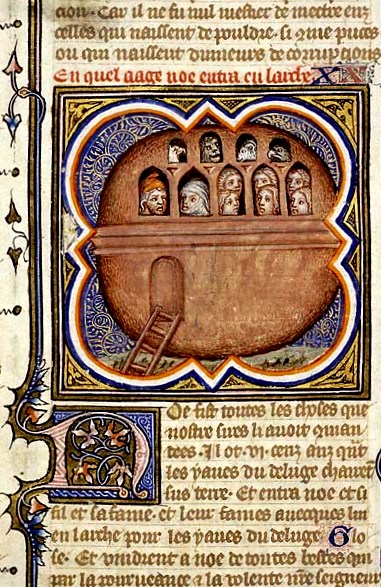
Noah and his family are inside the ark, safe from the swirling waters around them. God has locked them in, and the ladder falls away from the entrance.
This beautiful manuscript illustration shows the anxious faces not only of the humans inside the ark, but the birds and animals as well. Will they be saved?
Noah, wearing a medieval cap, faces his wife, also in medieval headdress. Their sons stand close to each wife, supporting each other in this terrifying situation.
Notice that the ark is in the shape of a shell: it holds the seed of a new humanity, a new beginning for the earth.
Noah and his family, stained glass Master
Marienkirche, Germany, 14th century
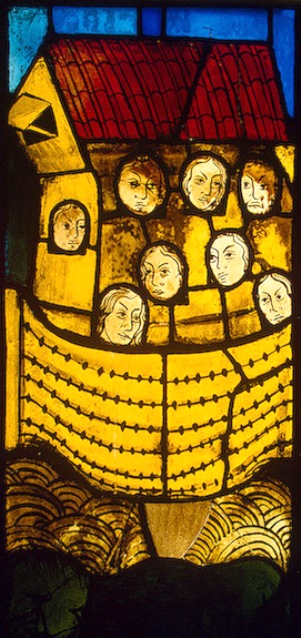
Noah (at left), his wife and his family shelter in the safety of the neatly tile-roofed ark, while the waters foam beneath them.
This stained glass window originally formed part of the Marienkirche, but was ‘transferred’ from Germany to the Hermitage Museum, St Petersburg during World War II.
It is primitive in design, but effective nevertheless. Each face is different, individual – but all are somber. They seem uncertain that their little ark will survive the cataclysm outside.
‘The Return of the Dove to the Ark’, Sir John Everett Millais, 1851
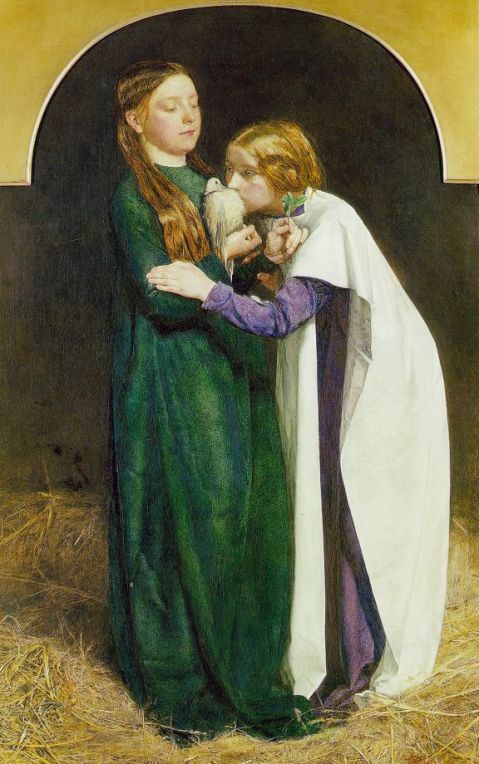
Inside the art Noah’s family shelters – including the young wives of his three sons Shem, Ham and Japheth. These are two of the young wives, fondling one of the young doves that Noah has collected.
The rain has stopped and the Flood is beginning to subside. But is it safe yet to leave the ark? Noah sends out a raven.
Why? Sending out a land bird (as opposed to a sea bird who can land on water) is an old mariner’s trick. A land bird, knowing it will drown if it lands, immediately flies straight up as high as it can, to try to spot land.
- If it sees land, it will head for it and thereby show the mariner below which way land lies.
- If it cannot see land, it will return to the boat, and the mariner knows he must continue searching.
Noah’s first bird cannot find a tree in which to roost. So Noah waits, then sends out a dove. It returns, unable to find a footing.
Again Noah waits, then sends out the dove, hoping it will find a resting place. It returns with an olive twig in its beak. Noah knows that trees are now appearing above the water.
Millais has shown this moment. The two young women fondle the dove, now a signal of hope for them all.
‘Noah’, Frank Wesley, 1980’s
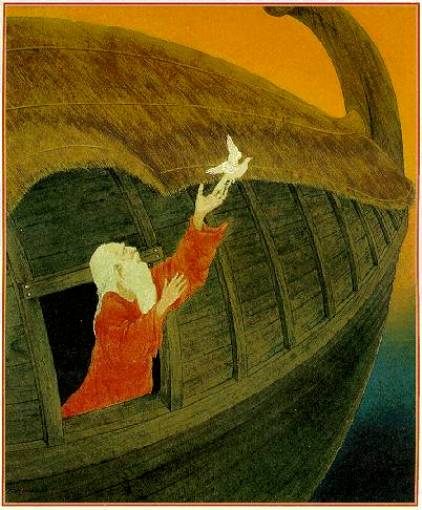
Noah opens a hatch in the side of the ark and releases the dove, hoping it will give him some sign that the waters have receded.
The themes and stories of the Bible have universal appeal. Here is an Indian interpretation of the story of Noah – note the design of the ark, based on Indian boats.
The dove leaving Noah’s hand seems almost an extension of Noah himself; both are straining upwards out of the darkness of the ark.
A good man in a wicked world.
Leaving the Ark
‘The Subsiding of the Waters of the Deluge’, Thomas Cole, 1829
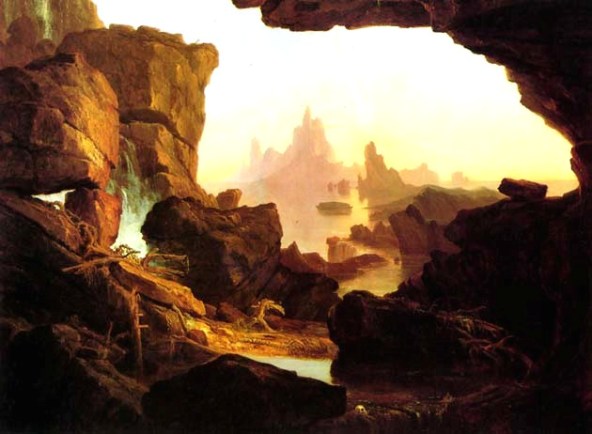
The deluge has ceased, the waters recede, and a new dawn opens up for the Earth.
The most startling quality of this painting is the clarity of light. It is as if the whole world has been washed clean of every tarnish, and now lies ready for a new beginning.
Certainly wreckage is strewn in the forefront of the painting, and the ground is still awash with the receding floodwater, but light coming from some point at the right of the picture seems to announce the new world that God is offering Noah.
Was this the scene that greeted Noah when he removed the covering from the door of the ark?
Building an Altar
‘The Sacrifice of Noah’, Michelangelo, 1508-12
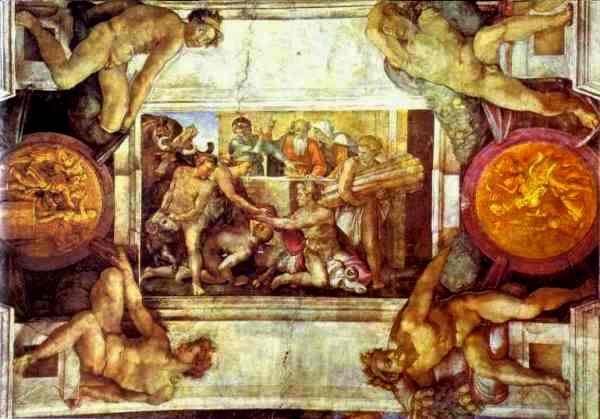
The first thing that Noah did when he and his family left the ark was to build an altar and offer sacrifice to God, in thanks for their deliverance.
They heap up the sacrificial flames and prepare to make an offering of thanksgiving to God. Michelangelo has represented each member of the family here – none are omitted.
Notice the detail of the slaughtered animals, and of the son with muscles straining under the load of firewood.
For a reconstruction of a sacrificial altar from biblical times, see Altars of Sacrifice in the ancient world.
‘The Sacrifice of Noah’, Jacopo Bassano, circa 1574
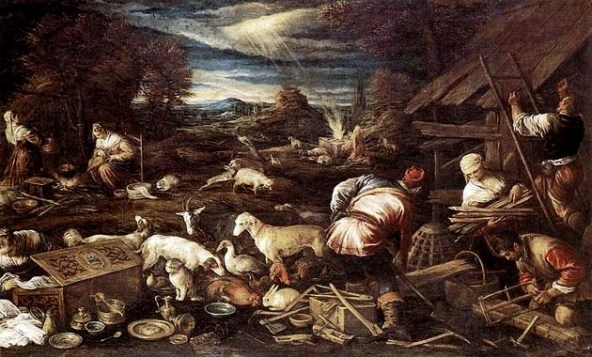
The ground is strewn with wreckage, but Noah and his family are alive. They build an altar to God in thanksgiving for their safe passage through the disaster of the Flood, then set to at their task of rebuilding.
The wreckage caused by the floodwaters is all too evident in the painting by Bassano. He concentrates on the task that Noah and his family face: of rebuilding a home and beginning all over again.
- The ground is strewn with their possessions, and the men have already set to in an attempt to provide shelter.
- The women do what women always do in a bad situation: get a meal going.
- Only the animals look nonplussed, dazed.
In the background, removed from this hive of activity, Noah prays to God in thanks for the deliverance of his family.
‘Noah’s Ark’, unknown Italian artist, late 16th century
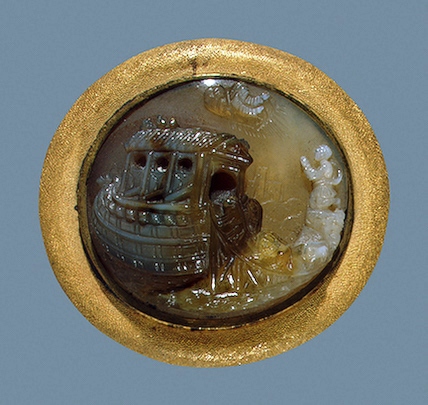
Noah raises his hands in a prayer of thanksgiving to God. The ark, now emptied of its precious cargo, rests on firm ground at last.
This miniature agate carving was originally from the collection of the Duke d’Orleans. It was a devotional object for personal prayer. Presumably the person who carried it would be inspired by Noah’s prayerful attitude to thank God as Noah had done for deliverance, and for safety.
‘Noah’s Altar’, Antonio Carracci
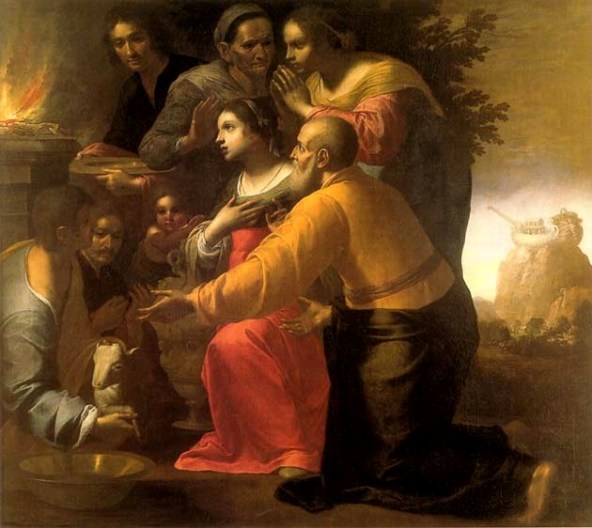
The flames of the sacrificial altar rise up, so that ‘the Lord smelled the pleasing odor’. Noah and his family give thanks to God, who promises never again to destroy the earth with water.
Notice the ark to the right of the painting, behind Noah. It is perched rather precariously on the peak of Mount Ararat.
Notice too that most of the family have their backs turned towards it, and are focusing instead of the altar of thanksgiving.
They must leave the past and focus on the future, and worship God who saved them.
The Drunken Noah
‘The Drunken Noah’, Giovanni Bellini
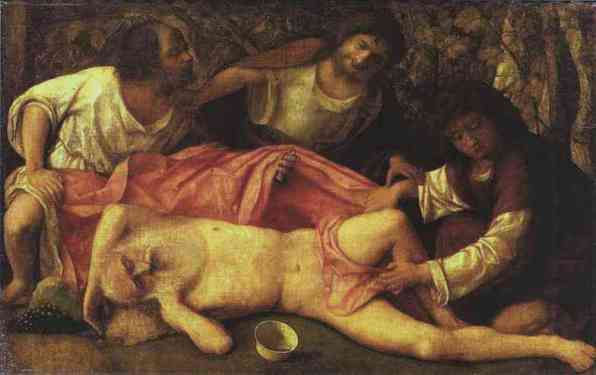
Noah has fallen drunkenly to the floor, and Ham is laughing – not just at his father’s inebriation, but at his nakedness.
The laughter of Ham denoted a lack of respect, and in the hierarchical tribal system this was a serious flouting of protocol.
Shem and Japheth, on the other hand, avert their eyes from Noah’s nakedness.
Noah seems oblivious to it all, and his body is bathed in a curious golden glow, perhaps denoting the oblivion of drunken sleep. The grapes and cup have fallen to the floor.
‘The Drunkenness of Noah’, Michelangelo Buonarroti, 1509
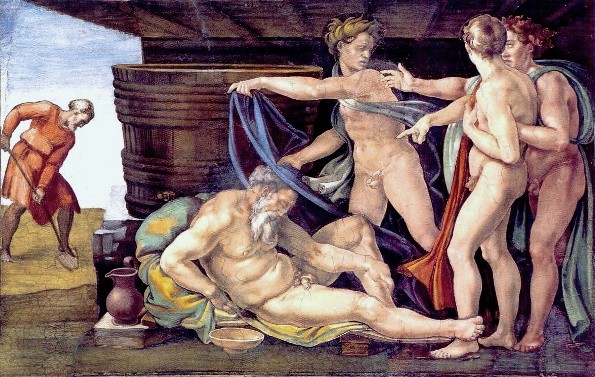
Two of the brothers, Shem and Japheth, avert their eyes from their father’s naked body, while one of them attempts to cover Noah with a piece of cloth.
This painting is part of the ceiling of the Sistine Chapel in Rome. At the left is an image of Noah, the first tiller of the soil.
But the main part of the painting shows the drunken Noah, unaware of his own nakedness. One son points this out to his brothers, who try to cover Noah.
Curiously, Michelangelo has shown all of the men naked, suggesting that it is not the nakedness that is the problem, but Ham’s mirth at his defenseless father’s predicament.
Flask with scenes of Noah’s Intoxication, unknown Italian artist, 1540’s
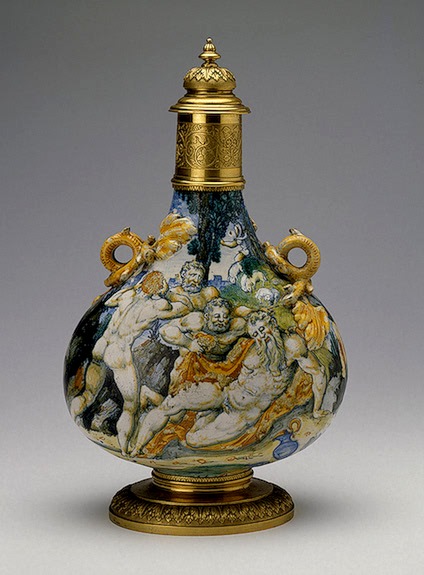
Noah falls helplessly to the ground, overcome by too much wine. One son, Ham, laughs at his father’s nakedness, while the others, Shem and Japheth, avert their eyes. They will not share in Ham’s derision of his father.
Curiously, the artist has shown all the men in this picture naked. Lack of clothes, therefore, was not the problem. It was the son’s lack of respect for his father, even when his father could not be said to deserve it, that was the pivotal offense calling forth God’s punishment.
Ham, who laughed, would be the father of the Canaanites, despised enemies of the Hebrew people.
Save
Hidden Meanings in paintings of Noah
- Noah is usually shown as old, with a white beard, suggesting he was wise.
- The Flood was likened to Christian baptism by the early Church, and a ship became a common symbol of the Church itself.
- Accounts of a great flood occur in the folk-history of peoples all over the world.
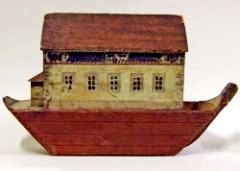
Child’s toy Ark, 18-19th century
- Painters of the Ark often ignore the structural details given in Genesis. In early Christian painting in the Roman catacombs the ark appears as a simple coffin-shaped box; in medieval art, a kind of floating house; and in the Renaissance as a boat modelled on contemporary ships.
- A favorite scene shows the wicked fleeing from the rising waters. The ark floats amid the pouring rain. Animals stand on deck or sometimes peer through portholes.
- Paintings of the drunkenness of Noah are rare: they show Noah in a poor light.
- Ham, the son who mocked his father Noah, was supposed to be the forefather of the Canaanites, enemies of the Hebrews.
- The mocking of Noah by Ham was seen by the Christian Church as a prefiguration of the mocking of Christ on the cross.
- Rabbinic commetary stated that Ham not merely saw his father’s nakedness but that he castrated him, an element of the story that was omitted from Genesis. This form of the story may be connected to the ancient myth of Uranus and Cronus.
It’s the End of the World!! Noah’s story
Noah was a good man in a corrupt world. He walked with God.
He had a wife, three sons, Shem, Ham and Japheth, and three daughters-in-law.
God saw the corruption and depravity of the world, and regretted creating people. But what He had created, He could destroy. Noah would be an exception. God would spare him and his family. He told Noah what He was about to do, and directed him to build an ark. In the ark he was to put pairs of all the animals and birds on the earth.
Noah was a contrarian. Despite the jeers of the people around him, Noah built the ark, collected the animals and birds, and prepared for the worst.
It came. God opened the heavens and flooded the earth. Nothing and no-one was spared. Except every living creature in the Ark. And the fish, of course.
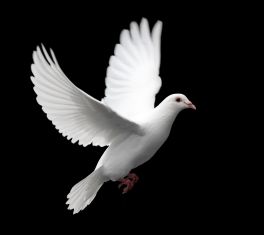 Noah and his family, locked inside the ark, were safe. Eventually the rain stopped. A wind, the breath of God, blew over the waters and they began to recede. Noah sent out birds to see what they would do. At first they could find nowhere to perch, but then one of them, a dove, failed to come back to the ark, and Noah knew it had found a branch on which to perch.
Noah and his family, locked inside the ark, were safe. Eventually the rain stopped. A wind, the breath of God, blew over the waters and they began to recede. Noah sent out birds to see what they would do. At first they could find nowhere to perch, but then one of them, a dove, failed to come back to the ark, and Noah knew it had found a branch on which to perch.
When the earth was finally dry, God told Noah to leave the ark, freeing all the animals and birds as well.
The first thing that Noah did was to build an altar of thanksgiving to God.
God made Noah a promise: that He would never again destroy all living creatures, as He had just done. As a sign of His promise, He made a rainbow across the sky.
Noah became the first tiller of the soil. He planted, among other things, a vineyard. When the grapes ripened he made wine, but he drank too much and became drunk. While he was drunk he threw off all his clothes and fell down, naked, on the ground.
His son Ham came in and saw him, and went off to get his brothers, so that they could see too. But they were more respectful towards their father, and shielded their eyes while they covered him.
When Noah woke up and heard what had happened, he was angry. He cursed Ham for his lack of respect. Ham was the father of Canaan, who was the forefather of the Canaanites, traditional enemies of the Hebrew people.
Noah’s Story in the Bible
The Wickedness of People, Genesis 6:5-8
The Lord saw that the wickedness of humankind was great in the earth, and that every inclination of the thoughts of their hearts was only evil continually.And the Lord was sorry that he had made humankind on the earth, and it grieved him to his heart. So the Lord said, ‘I will blot out from the earth the human beings I have created—people together with animals and creeping things and birds of the air, for I am sorry that I have made them.’ But Noah found favour in the sight of the Lord.
Command to build an Ark, Genesis 6:9-22
These are the descendants of Noah. Noah was a righteous man, blameless in his generation; Noah walked with God. And Noah had three sons, Shem, Ham, and Japheth. Now the earth was corrupt in God’s sight, and the earth was filled with violence. And God saw that the earth was corrupt; for all flesh had corrupted its ways upon the earth. And God said to Noah, ‘I have determined to make an end of all flesh, for the earth is filled with violence because of them; now I am going to destroy them along with the earth. Make yourself an ark of cypress wood; make rooms in the ark, and cover it inside and out with pitch. This is how you are to make it: the length of the ark three hundred cubits, its width fifty cubits, and its height thirty cubits. Make a roof for the ark, and finish it to a cubit above; and put the door of the ark in its side; make it with lower, second, and third decks. For my part, I am going to bring a flood of waters on the earth, to destroy from under heaven all flesh in which is the breath of life; everything that is on the earth shall die. But I will establish my covenant with you; and you shall come into the ark, you, your sons, your wife, and your sons’ wives with you. And of every living thing, of all flesh, you shall bring two of every kind into the ark, to keep them alive with you; they shall be male and female. Of the birds according to their kinds, and of the animals according to their kinds, of every creeping thing of the ground according to its kind, two of every kind shall come in to you, to keep them alive. Also take with you every kind of food that is eaten, and store it up; and it shall serve as food for you and for them.’ Noah did this; he did all that God commanded him.
The Great Flood, Genesis 7:1-24
Then the Lord said to Noah, ‘Go into the ark, you and all your household, for I have seen that you alone are righteous before me in this generation. Take with you seven pairs of all clean animals, the male and its mate; and a pair of the animals that are not clean, the male and its mate; and seven pairs of the birds of the air also, male and female, to keep their kind alive on the face of all the earth. For in seven days I will send rain on the earth for forty days and forty nights; and every living thing that I have made I will blot out from the face of the ground.’ And Noah did all that the Lord had commanded him. Noah was six hundred years old when the flood of waters came on the earth. And Noah with his sons and his wife and his sons’ wives went into the ark to escape the waters of the flood. Of clean animals, and of animals that are not clean, and of birds, and of everything that creeps on the ground, two and two, male and female, went into the ark with Noah, as God had commanded Noah. And after seven days the waters of the flood came on the earth. In the six-hundredth year of Noah’s life, in the second month, on the seventeenth day of the month, on that day all the fountains of the great deep burst forth, and the windows of the heavens were opened.
12The rain fell on the earth for forty days and forty nights.
13On the very same day Noah with his sons, Shem and Ham and Japheth, and Noah’s wife and the three wives of his sons, entered the ark,
14they and every wild animal of every kind, and all domestic animals of every kind, and every creeping thing that creeps on the earth, and every bird of every kind—every bird, every winged creature.
15They went into the ark with Noah, two and two of all flesh in which there was the breath of life. And those that entered, male and female of all flesh, went in as God had commanded him; and the Lord shut him in. The flood continued for forty days on the earth; and the waters increased, and bore up the ark, and it rose high above the earth.
18The waters swelled and increased greatly on the earth; and the ark floated on the face of the waters.
19The waters swelled so mightily on the earth that all the high mountains under the whole heaven were covered;
20the waters swelled above the mountains, covering them fifteen cubits deep.
21And all flesh died that moved on the earth, birds, domestic animals, wild animals, all swarming creatures that swarm on the earth, and all human beings;
22everything on dry land in whose nostrils was the breath of life died.
23He blotted out every living thing that was on the face of the ground, human beings and animals and creeping things and birds of the air; they were blotted out from the earth. Only Noah was left, and those that were with him in the ark.
24And the waters swelled on the earth for one hundred and fifty days.
The Flood Subsides, Genesis 8:1-19
But God remembered Noah and all the wild animals and all the domestic animals that were with him in the ark. And God made a wind blow over the earth, and the waters subsided;
2the fountains of the deep and the windows of the heavens were closed, the rain from the heavens was restrained,
3and the waters gradually receded from the earth. At the end of one hundred and fifty days the waters had abated; and in the seventh month, on the seventeenth day of the month, the ark came to rest on the mountains of Ararat. The waters continued to abate until the tenth month; in the tenth month, on the first day of the month, the tops of the mountains appeared. At the end of forty days Noah opened the window of the ark that he had made and sent out the raven; and it went to and fro until the waters were dried up from the earth. Then he sent out the dove from him, to see if the waters had subsided from the face of the ground; but the dove found no place to set its foot, and it returned to him to the ark, for the waters were still on the face of the whole earth. So he put out his hand and took it and brought it into the ark with him. He waited another seven days, and again he sent out the dove from the ark; and the dove came back to him in the evening, and there in its beak was a freshly plucked olive leaf; so Noah knew that the waters had subsided from the earth. Then he waited another seven days, and sent out the dove; and it did not return to him any more. In the six hundred and first year, in the first month, on the first day of the month, the waters were dried up from the earth; and Noah removed the covering of the ark, and looked, and saw that the face of the ground was drying. In the second month, on the twenty-seventh day of the month, the earth was dry. Then God said to Noah, ‘Go out of the ark, you and your wife, and your sons and your sons’ wives with you. Bring out with you every living thing that is with you of all flesh—birds and animals and every creeping thing that creeps on the earth—so that they may abound on the earth, and be fruitful and multiply on the earth.’ So Noah went out with his sons and his wife and his sons’ wives. And every animal, every creeping thing, and every bird, everything that moves on the earth, went out of the ark by families.
God’s Promise to Noah, Genesis 8:20-22
Then Noah built an altar to the Lord, and took of every clean animal and of every clean bird, and offered burnt-offerings on the altar. 21And when the Lord smelt the pleasing odor, the Lord said in his heart, ‘I will never again curse the ground because of humankind, for the inclination of the human heart is evil from youth; nor will I ever again destroy every living creature as I have done.
22As long as the earth endures, seedtime and harvest, cold and heat, summer and winter, day and night, shall not cease.’
The Covenant with Noah, Genesis 9:1-17
God blessed Noah and his sons, and said to them, ‘Be fruitful and multiply, and fill the earth. The fear and dread of you shall rest on every animal of the earth, and on every bird of the air, on everything that creeps on the ground, and on all the fish of the sea; into your hand they are delivered. Every moving thing that lives shall be food for you; and just as I gave you the green plants, I give you everything. Only, you shall not eat flesh with its life, that is, its blood. For your own lifeblood I will surely require a reckoning: from every animal I will require it and from human beings, each one for the blood of another, I will require a reckoning for human life. Whoever sheds the blood of a human,
by a human shall that person’s blood be shed;
for in his own image God made humankind. And you, be fruitful and multiply, abound on the earth and multiply in it.’ Then God said to Noah and to his sons with him, ‘As for me, I am establishing my covenant with you and your descendants after you, and with every living creature that is with you, the birds, the domestic animals, and every animal of the earth with you, as many as came out of the ark. I establish my covenant with you, that never again shall all flesh be cut off by the waters of a flood, and never again shall there be a flood to destroy the earth.’ God said, ‘This is the sign of the covenant that I make between me and you and every living creature that is with you, for all future generations: I have set my bow in the clouds, and it shall be a sign of the covenant between me and the earth. When I bring clouds over the earth and the bow is seen in the clouds, I will remember my covenant that is between me and you and every living creature of all flesh; and the waters shall never again become a flood to destroy all flesh. When the bow is in the clouds, I will see it and remember the everlasting covenant between God and every living creature of all flesh that is on the earth.’ God said to Noah, ‘This is the sign of the covenant that I have established between me and all flesh that is on the earth.’
Noah the First Farmer, Genesis 9:18-29
The sons of Noah who went out of the ark were Shem, Ham, and Japheth. Ham was the father of Canaan.
19These three were the sons of Noah; and from these the whole earth was peopled. Noah, a man of the soil, was the first to plant a vineyard. He drank some of the wine and became drunk, and he lay uncovered in his tent. And Ham, the father of Canaan, saw the nakedness of his father, and told his two brothers outside. Then Shem and Japheth took a garment, laid it on both their shoulders, and walked backwards and covered the nakedness of their father; their faces were turned away, and they did not see their father’s nakedness.When Noah awoke from his wine and knew what his youngest son had done to him, he said,
‘Cursed be Canaan;
lowest of slaves shall he be to his brothers.’
He also said,
‘Blessed by the Lord my God be Shem;
and let Canaan be his slave.
May God make space for Japheth,
and let him live in the tents of Shem;
and let Canaan be his slave.’ After the flood Noah lived for three hundred and fifty years.
29All the days of Noah were nine hundred and fifty years; and he died.
Bible Art: Paintings and Artworks from the Old and New Testament: Noah, the Great Flood or Deluge, the First Farmer – Bible Study Resource
Noah & the Flood links
So the Lord said, ‘I will blot out from the earth the human beings I have created— for I am sorry that I have made them.’ But Noah found favour in the sight of the Lord.
Wine, beer
in the ancient world
‘He planted, among other things, a vineyard. When the grapes ripened he made wine, but he drank too much and became drunk. While he was drunk he threw off all his clothes and fell down, naked, on the ground.’
‘The ziggurats were simulated mountains, and many of the people in the ancient Near East continued to worship in ‘high places’.
Read more…
‘As far as ordinary people were concerned, the gods of fertility were all around, a daily experience. They were not remote or invisible.
They were easy to identify with, since they reflected humanity. The gods and goddesses did all the things that people do. They had sex, got angry, fell in love, quarreled with their families, and expressed what was best and worst in human nature.’
‘We can get a good idea of boat building techniques from the ancient boat dated back to the 1st century AD, discovered buried in mud near the town of Magdala.’
© Copyright 2006
Elizabeth Fletcher

